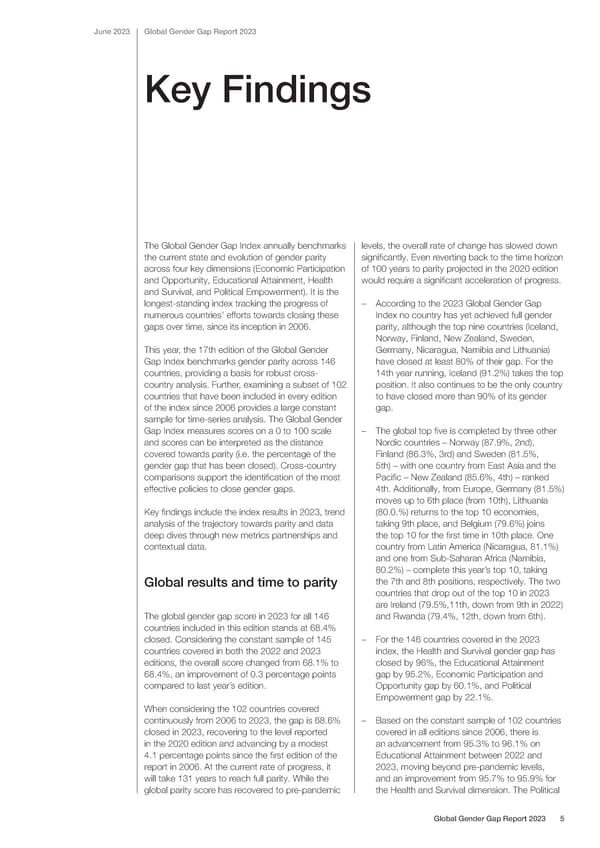June 2023 Global Gender Gap Report 2023 Key Findings The Global Gender Gap Index annually benchmarks levels, the overall rate of change has slowed down the current state and evolution of gender parity signi昀椀cantly. Even reverting back to the time horizon across four key dimensions (Economic Participation of 100 years to parity projected in the 2020 edition and Opportunity, Educational Attainment, Health would require a signi昀椀cant acceleration of progress. and Survival, and Political Empowerment). It is the longest-standing index tracking the progress of – According to the 2023 Global Gender Gap numerous countries’ efforts towards closing these Index no country has yet achieved full gender gaps over time, since its inception in 2006. parity, although the top nine countries (Iceland, Norway, Finland, New Zealand, Sweden, This year, the 17th edition of the Global Gender Germany, Nicaragua, Namibia and Lithuania) Gap Index benchmarks gender parity across 146 have closed at least 80% of their gap. For the countries, providing a basis for robust cross- 14th year running, Iceland (91.2%) takes the top country analysis. Further, examining a subset of 102 position. It also continues to be the only country countries that have been included in every edition to have closed more than 90% of its gender of the index since 2006 provides a large constant gap. sample for time-series analysis. The Global Gender Gap Index measures scores on a 0 to 100 scale – The global top 昀椀ve is completed by three other and scores can be interpreted as the distance Nordic countries – Norway (87.9%, 2nd), covered towards parity (i.e. the percentage of the Finland (86.3%, 3rd) and Sweden (81.5%, gender gap that has been closed). Cross-country 5th) – with one country from East Asia and the comparisons support the identi昀椀cation of the most Paci昀椀c – New Zealand (85.6%, 4th) – ranked effective policies to close gender gaps. 4th. Additionally, from Europe, Germany (81.5%) moves up to 6th place (from 10th), Lithuania Key 昀椀ndings include the index results in 2023, trend (80.0.%) returns to the top 10 economies, analysis of the trajectory towards parity and data taking 9th place, and Belgium (79.6%) joins deep dives through new metrics partnerships and the top 10 for the 昀椀rst time in 10th place. One contextual data. country from Latin America (Nicaragua, 81.1%) and one from Sub-Saharan Africa (Namibia, 80.2%) – complete this year’s top 10, taking Global results and time to parity the 7th and 8th positions, respectively. The two countries that drop out of the top 10 in 2023 are Ireland (79.5%,11th, down from 9th in 2022) The global gender gap score in 2023 for all 146 and Rwanda (79.4%, 12th, down from 6th). countries included in this edition stands at 68.4% closed. Considering the constant sample of 145 – For the 146 countries covered in the 2023 countries covered in both the 2022 and 2023 index, the Health and Survival gender gap has editions, the overall score changed from 68.1% to closed by 96%, the Educational Attainment 68.4%, an improvement of 0.3 percentage points gap by 95.2%, Economic Participation and compared to last year’s edition. Opportunity gap by 60.1%, and Political Empowerment gap by 22.1%. When considering the 102 countries covered continuously from 2006 to 2023, the gap is 68.6% – Based on the constant sample of 102 countries closed in 2023, recovering to the level reported covered in all editions since 2006, there is in the 2020 edition and advancing by a modest an advancement from 95.3% to 96.1% on 4.1 percentage points since the 昀椀rst edition of the Educational Attainment between 2022 and report in 2006. At the current rate of progress, it 2023, moving beyond pre-pandemic levels, will take 131 years to reach full parity. While the and an improvement from 95.7% to 95.9% for global parity score has recovered to pre-pandemic the Health and Survival dimension. The Political Global Gender Gap Report 2023 5
 Global Gender Gap Report 2023 Page 4 Page 6
Global Gender Gap Report 2023 Page 4 Page 6